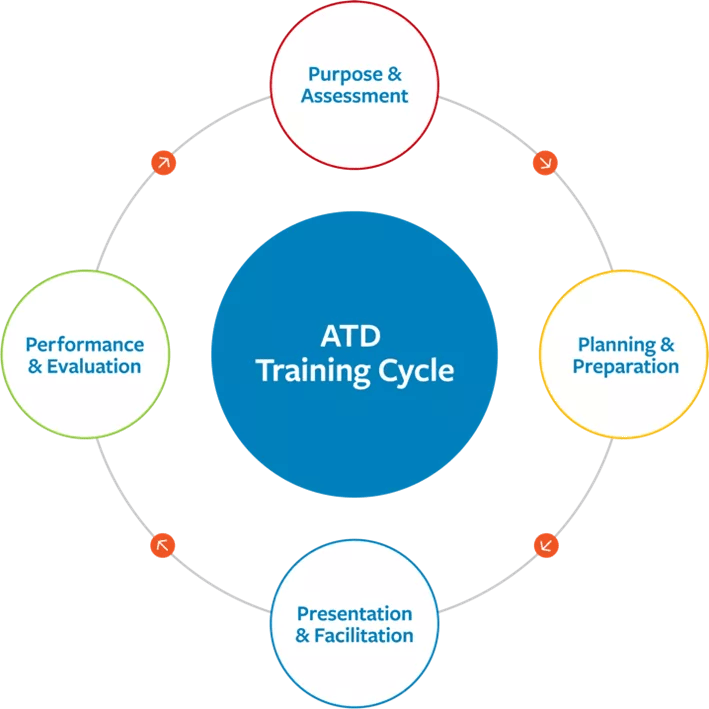What Is Train the Trainer?
Why Train the Trainer Is Important
Research indicates that the shelf life for skills may be five years or less. We are in a cycle of near constant upskilling and reskilling of the workforce. Train the trainer programs equip trainers and instructional designers with the skills they need to provide the best learning experience to employees. L&D professionals must keep their knowledge and skills updated to stay relevant and ensure their work creates desired impact. Delivering effective and engaging employee training is an art and a science. It isn’t simply about putting someone in front of a classroom to facilitate or show a person how to do something. Training is a process that begins well before the training course itself and extends beyond the close of it. Instrumental to the success of a train the trainer program is selecting the correct person to act as the facilitator. This person must not only be an expert on the content and on designing training, but also must be well-respected, experienced, patient, and passionate. Train the trainer facilitators also need to have strong leadership skills, communication capabilities, exceptional listening skills, and emotional intelligence, according to the Talent Development Body of Knowledge. In addition to these interpersonal skills and their subject matter expertise, trainers need to understand adult learning principles and be able to engage learners. In train the trainer workshops, participants learn an array of training techniques, best practices, and activities from the certified trainer that they can employ to help the individuals they will be training understand and retain information. Train the trainer course participants also may receive information on ways to harness the technology that is critical to how we work and learn today.To have the desired impact during a train the trainer program, trainers will design a course with material that matters to the learner. But behavior change goes beyond the learner themselves, the ecosystem in which the learner works is also a factor in behavior change. Is the manager supportive? Is there an opportunity to practice what one has learned? Further, the trainer must understand why training makes an organizational impact.
What Are the Advantages of Train the Trainer?
A train the trainer model expands an organization’s training capacity. This can save money on external trainers, upskill an organization’s staff more quickly, and lead to consistency in training. The train the trainer process also promotes peer-to-peer learning. Finally, an internal SME-turned trainer understands the organization’s culture and potential roadblocks the learner may encounter when trying to practice the new learning on the job. For the initial expert trainer, who now has a cadre of other trainers, the freed-up time can be used to serve as a business consultant on other departmental development needs, thus adding value to the entire organization. Taking part in a train the trainer program also might be a stretch goal for some employees, helping them share information on a topic they love. They can serve as a resource post-training, either to the course participant or to that individual’s manager, by offering guidance on how to put the learning to practice, such as via a learning plan.
How Do You Build a Train the Trainer Program?
To build a train the trainer program, it is critical to take into consideration what the learner needs to know to perform well on the job—both the technical expertise and the soft skills. The ATD Training Cycle is a four-step process that trainers can use to prepare for and to facilitate a train-the-trainer course. It comprises:
Purpose and assessment
Planning and preparation
Presentation and facilitation
Performance and evaluation

Purpose and assessment is about understanding why the training is needed and how it connects to the organization. This is done through a needs assessment. During this phase, a trainer also will decide upon the method by which to measure what post-training success looks like—that is, are learning objectives being met and are the learned skills being applied by the learners on the job? According to ATD’s Talent Development Capability Model, knowledge of needs assessment approaches and techniques are part of the instructional design knowledge and skills within the developing professional capability domain.
Planning and preparation allows trainers to ensure that they have a full grasp of the material they are covering during the course. Having this depth of knowledge will inspire confidence from the participants. This phase also means understanding the flow of the program and activities planned for the course:
Do you have enough time to cover all the material?
Will the material as presented be in a logical sequence for learners and are there appropriate transitions between section material?
Do you know when you will take breaks?
Are activities timed in such a way to keep learners engaged and get them up and moving to avoid an afternoon slump?
Additionally, planning and preparation include the logistical elements of the training course: classroom setup; food and beverages, if appropriate; additional space if you need it for break-out activities; and making sure accommodations are accessible and meet dietary requests of participants. For online courses, consider breakout rooms, whether job aids are needed for participants with respect the technology that will be used, and accessibility, such as having instructions closed-captioned.
The presentation and facilitation phase is about your training techniques. Will learners understand your stories and references? If some participants are not native speakers of the language in which you’re delivering the training, for example, they may not relate to the content you’re using to make your point. Can you manage a participant who doesn’t want to learn and is disruptive of the learning of others? Will learners enjoy small team activities? Is self-reflection a better activity to utilize? Are you facilitating in a hybrid environment where some people are in a classroom and others are online? You want learners engaged and energized as well as understanding the content you’re covering.
Performance and evaluation is where you determine whether all of your work has been successful. This goes back to the purpose and assessment phase where you outlined what successful completion of the course would look like. What data or insights do you need to collect to determine if you have achieved it?
Even seasoned trainers can benefit from creating a written plan for their training course, which they can check and review during the event.
Employing Train the Trainer to Prepare for Tomorrow
Research shows that training and development programs done well correlate to higher levels of employee engagement and retention. Job candidates who are looking for employers of choice say that learning opportunities are a benefit they highly value.
ATD’s Effective Trainers: Traditional and Virtual Classroom Success research report shows that high-performing organizations are more likely to invest a greater amount in their trainers and the training function. Train the trainer programs can be a catalyst for organizations to not only scale, but greatly improve the efficacy of the L&D function.
How Can ATD Help?
Since our founding in 1943, ATD has been committed to helping talent development professionals excel in their roles. We provide trainers with the tools and knowledge they need to succeed by curating the best practices and insights from the world’s top experts. ATD empowers trainers to stay ahead of the latest training techniques and technologies, ensuring they can deliver impactful learning experiences.
To access to even more resources, including practical tools and templates, research, and insights, you’re invited to become an ATD member. For more information on training delivery, visit the following:

BLOGS
Training Delivery & Facilitation Topic Page
Explore training delivery articles for all levels. Find strategies, insights, and best practices to elevate your expertise. Start here!

NEWSLETTER
Training Delivery Newsletter
Curated content about delivering engaging learning experiences. Sign up today!

COURSES BY ROLE
Trainer / Facilitator
Still exploring options? ATD offers more train-the-trainer courses on a variety of specialized topics, including in-person and virtual training, and evaluating learning. Learn more!

EVENTS
ATD Events
Talent development professionals come together to give you conference experiences that are diverse in education, solutions, and opportunities. Learn more!

GLOSSARY TERM
Talent Development Glossary Terms
Learn about essential terms and need-to-know expressions for training and development professionals. Explore now!
Free Train-the-Trainer E-Book
Employing a train-the-trainer program could be an important part of your talent development solution. This e-book covers the dos and dont's for the new trainer, and key elements for training trainers with the Four-Step Skills Method.
